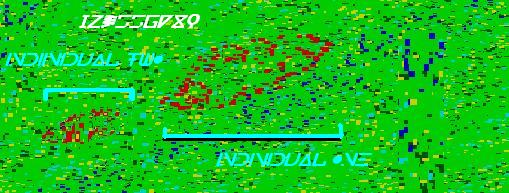BY LETTER
Rheolithoids
Silicon based non-sentient lifeform | |
 Image from Steve Bowers | |
| The first geophysical image of two living Rheolithoid individuals | |
On an Ionian subtype world orbiting JD 13188094 (a red dwarf ten light years from HD 2954/BD+15074 in Pisces), a Silicon Generation survey team found evidence of organised structure in essential pyroclasts amongst the sulphurous ejecta from several equatorial volcanoes. Using a high temperature probe with a magmatter core shunt for communication and cooling, the Generation discovered a connected series of volcanic pipes and sills girdling the globe, with a continuous fluid gas and lava environment permitting free movement of material.
In the magma chambers, 5-40 km under the surface, native rocks are broken and comminuted, melted and changed in a high energy environment. Organised structures have evolved from complicated interwoven silicaceous minerals such as kalsilite and melilite, together with impurities of, for instance, germanium and selenium in the matrix minerals resulting in a rheolithic self-replicating life-like system.
The Silicon Generation crystallographers studied these entities for hundreds of years, using geophysical sensing methods and dissection of non-living specimens. Eventually they produced a detailed description of the creatures.
Ever since their discovery there has been debate about whether these entities can be truly considered to be alive, but they display most, if not all, of the characteristics of a living entity. Many taxonomists classify these entities as life-like organisms or systems.
A variety of other life-like systems have been discovered in various locations in the universe, existing in various environments, some of which are natural, and other have been created artificially. A life-like system should fulfil certain criteria; autonomous acquisition of nutrients leading to growth, use of energy to grow and/or move and/or maintain a consistent internal state, reproduction and the capacity to retain the information required for reproduction, response to stimuli, and (probably) the capacity to evolve. The complexity of carbon-based organic molecules is known to permit all these qualities, but other systems also permit the same processes to occur, and the Rheolithoids are good examples of such life-like organisms.
Characteristics
The core of a Rheolithoid is a fine-grained nucleus of interwoven minerals, apparently related to a vortex crystal formation, but with a consistent asymmetrical organisation that is recognisably similar from one individual to another.Individuals are usually 0.1 to 10 metres in diameter, and mostly sessile, sometimes moving slowly towards a source of comminuted minerals or to avoid being absorbed by a larger individual. Wild Rheolithoids are no more self-aware than many sessile animals in an organic biota; they are comparable in intelligence to a sea anemone.
Information for the perpetuation of the organised system is stored in germanium and selenium intercalated in tiny data rich flat plaque minerals, while response to the environment is transmitted by slow oscillating reactions in glassy zeolites regulated by cation inclusions acting as messengers to and from the nucleus. The oscillating reactions cause tiny rotating cells to establish in the semimolten zeolite integument, permitting movement towards or away from stimuli.
The environment is detected by subduction of fine material between the rotating cells, which is then tested by an array of subcutaneous reactant mineral micrograins. Energy is stored in the rotating cells and in endothermic crystallization reactions.
The Generation found another Ionian subtype world orbiting BD+15.4074B and attempted to recreate the magmatic environment for the Rheolithoids, succeeding in 3665. They managed to produce a provolved intelligent form by 5080, which often can be found in high energy environments such as fusion drive cooling systems on Generation ships.
Related Articles
Appears in Topics
Development Notes
Text by Steve Bowers
Initially published on 20 October 2002.
Initially published on 20 October 2002.






